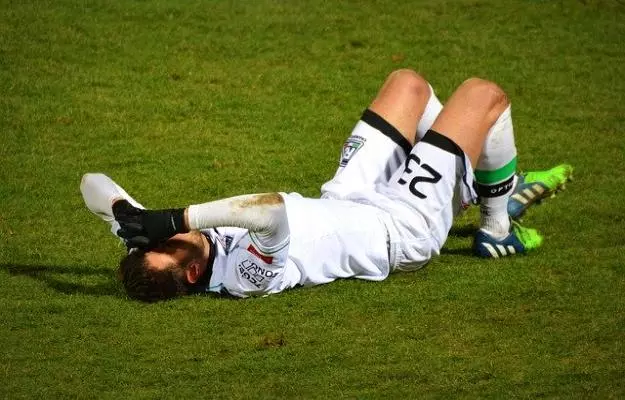Groin strains are some of the trickiest injuries to deal with, both for the person who has suffered one as well as the doctor who will eventually treat the injury. The groin area is a jumble of multiple muscles in the lower part of the pelvis.
Of course, injuries to the groin can happen to anyone, but they are more common among runners or those involved in playing sports that include a lot of running or jumping. Cricketers, hockey players, footballers and athletes involved in jumping or kicking sports usually experience the problem in their dominant leg because of the extra pressure they put on these muscles.
You may have seen athletes, either on television or in your running group, clutching their groin or walking gingerly after suffering an injury - unable to run after that. A groin strain or pull can be painful and severely limit your movement for a short period of time. However, a more severe strain could take about six weeks or more in recovery - if you are engaged in sports or a job that requires heavy lifting or strenuous travel, your doctor may advise you to avoid going back to work for a little while longer.
Physical therapy given by a trained professional and exercises recommended by your doctor may speed up the recovery in some cases. Over-the-counter medications could also help to deal with the pain of a groin injury in most cases.
- What is a groin pull or groin strain?
- Types of groin strain and groin strain pain
- Groin strain causes
- Groin strain symptoms
- Groin pull diagnosis
- Groin strain treatment
- Risk factors
- How to prevent groin strain
What is a groin pull or groin strain?
The groin comprises five muscles responsible for hip adduction (adductor muscles pull a body part towards the midline of the body). These muscles are adductor longus, adductor magnus, adductor brevis - which connect the legs to the hip region of the body - and the gracilis and pectineus muscles in the inner thighs. A tear in any of these muscles can cause pain and discomfort - this condition is known as a groin strain or groin pull.
Although a stretch, pull or tear can happen to any of these five muscles, the most commonly injured groin muscle is the adductor longus.
Most of the time, a groin strain is an acute injury (with sudden onset). However, tendinopathy (tendonitis) can develop over a longer time (chronic problem). Adductor tendonitis is a kind of groin strain.
The main function of the groin is to pull or keep your legs towards the centre of the body and stabilise the hip joint. But just like the word hip, the word groin is a loose reference for a group of muscles and tendons that make up the area.
Research conducted by the American Journal of Sports Medicine in 2004 found out that 10% of all Swedish Ice Hockey players suffered groin strains, while a study in the International Journal of Sports Medicine noted 32 groin strains among 180 male football players in a soccer division over the period of one year. Groin injuries are also more common among men than women in general.
Types of groin strain and groin strain pain
From mild to severe, a groin injury can vary in degrees. The determining factor for this is the pain you feel when you injure the area. Based on this, a groin injury can be categorized into three types:
- Grade 1: Mild discomfort and pain with a minor stretch or tear in one of the groin muscles. Usually, this type of injury heals within two or three weeks, with rest and home treatment.
- Grade 2: Characterised by moderate pain, this type of groin strain can make walking very difficult and is usually accompanied by some tissue damage. It can take up to six weeks to recover.
- Grade 3: Severe pain and loss of movement as well as strength in the inner thigh with a complete tear in the muscle and bruising.
Depending on which part of the groin - muscle, ligament or tendon - is hurt, a groin injury may be of three kinds:
- Groin pull: A pull or tear in any of the muscles in the groin.
- Adductor tendonitis: An inflammation in the tendons that link the hip adductor muscles to the pelvic bone, in the inner thigh and upper thigh region.
- Gilmore's groin: Also called sportsmen's groin and athletic pubalgia, this condition occurs as a result of tissue damage near the inguinal ligament - in the region where the leg meets the torso.
Groin strain causes
A lot of groin injuries go unreported as smaller strains can go away with rest, but more serious injuries can be debilitating and have a longer recovery time. Even though a majority of such injuries happen on the sports field, there are various factors that can lead to a groin strain:
- Stretching the muscles beyond their limit.
- Falling down
- Intense physical activity without proper warm-up or stretching.
- Turning or stopping suddenly while running.
- Lifting heavy weights like during a deadlift.
- Getting hit in the groin can damage muscle fibres and tissues.
- Training with resistance bands and tubes can increase the chances of pulling or tearing a muscle during the exercise.
Groin strain symptoms
An injury to the groin is easy to spot, even from a distance - the injured person usually has difficulty walking. But there are other tell-tale signs as well:
- In the case of a tear, the person can often hear a popping sound at the time of getting the injury.
- Pain in the inner thigh while moving the upper leg, walking or while lifting the knee.
- Tenderness in the groin area.
- Swelling in the affected inner thigh.
While all these symptoms point to a groin strain, there are some cases when similar symptoms also present in the case of bursitis in the hip, a stress fracture in the pelvis or the thigh bone (femur), or even a sprain in the hip.
Groin pull diagnosis
In some cases, the patient can hear a popping sound while playing a sport or running, followed by severe pain in the groin. Usually, this is points to a muscle tear. Visit a doctor immediately if this happens.
In other cases, the groin pain may be less severe or occur only while performing certain activities like running. It is a good idea to have this checked out by a doctor.
To make a diagnosis, your doctor will start by asking you some questions.
- The doctor will ask about the nature of your injury, the location of the pain and how it happened.
- He/she will then perform a physical exam to ascertain the range of movement you have in your leg, and the severity of the pain you’re experiencing.
- In more severe cases, the doctor would recommend getting an X-ray to rule out fractures.
- An additional MRI scan is recommended to determine the extent and exact location of the injury.
Groin strain treatment
An injured groin can be frustrating for someone used to moving about and being active all the time. Because of the nature of the injury, even a basic function like as walking is hampered, and recovery can take several weeks. But here are some commonly used treatment methods in the case of a groin pull:
- RICE therapy is the first step towards recovery. Rest, ice, compression and elevation (RICE) can help to reduce swelling due to an injury. Elevation of the groin can be achieved by placing a cushion under the lower back or hips.
- Over-the-counter painkillers like ibuprofen can help to bring down the pain and swelling as well.
- While a majority of grade 1 groin strains are treated with the two methods mentioned above, more severe cases can be tackled with physical therapy and gentle exercise.
- Wearing a thigh wrap or bandage for additional support to the injured muscles can reduce pain to some extent and aid recovery.
- Begin with light exercises that focus on mobility, stretching and strengthening.
- In the case of a tendon tear, surgery may also be required.
Risk factors
An injury can strike at any time. Knowing your body well and keeping healthy go a long way to prevent illness as well as injury. That said, performing some tasks can increase your risk of a groin injury. These include:
- Playing any intense sport like football, cricket, basketball, tennis or badminton, where there are sudden changes in direction, jumping or stretching of the limbs involved.
- Not warming up properly or stretching before the start of a training session or a game.
- For those who do weight training or strength training, not doing enough flexibility exercises can make their muscles too stiff, which can cause strains.
- If you have suffered a groin strain before, chances are that you can injure your groin again. Especially if you are impatient and resume the activity that gave you the groin injury too soon.
How to prevent groin strain
Groin injuries can take a frustratingly long time for recovery - causing you to miss out on work, exercises and even socialising as you recover. Naturally, preventing an injury from happening altogether will stand you in good stead. Here are a few methods:
- Warm-up and stretch your muscles before beginning a workout or a sport. Cold muscles are one of the common causes of injury.
- Work on strengthening your inner thigh muscles that form the groin. If you’re a running enthusiast, work on increasing the flexibility of your hips and thigh muscles as well as strengthening them by doing weighted exercises. Yoga may also help open up the hips and strengthen the inner thighs.
- Ease into a physical activity if you have taken a break from it.
- Because a groin injury typically happens on the stronger leg, work on gaining strength in the weaker leg.
- Stop immediately when you feel any discomfort in your groin and rest.
- Try out different sports that make you work on different parts of the body rather than straining the same muscles.
- Once you regain your strength and full range of motion, try not to resume the activity that caused the injury immediately - it may be beneficial to switch to a less intense exercise or sport, at least temporarily.
Like most musculoskeletal disorders, groin strains are extremely unpredictable, and if you have suffered one once, there is a chance of re-injuring it. A key factor in limiting the damage and returning to full fitness is a quick diagnosis, and following the treatment and recovery routine without adequate time to rest and recuperate.
Find Sports Medicine Physician in cities
Doctors for Groin Strain

Dr. Bhushan Borde
General Physician
3 Years of Experience

Dr. Gurmeet Singh
General Physician
2 Years of Experience

Dr. Suhas Chauhan
General Physician
11 Years of Experience











